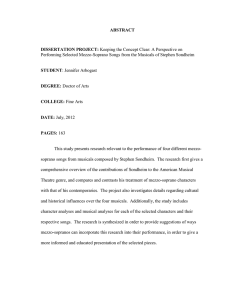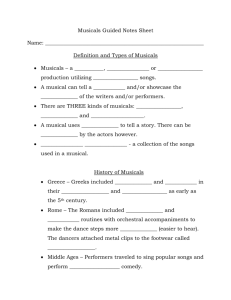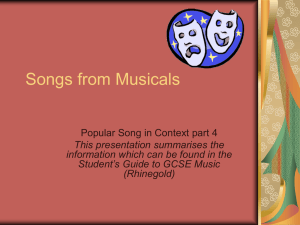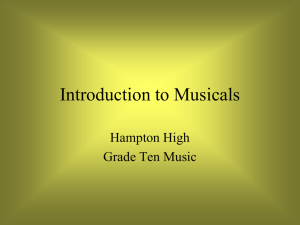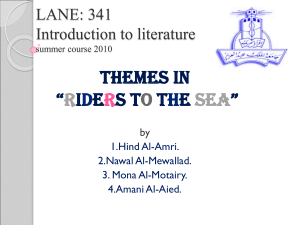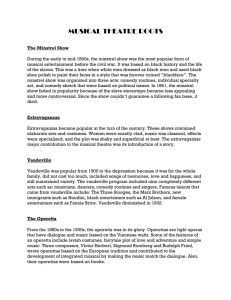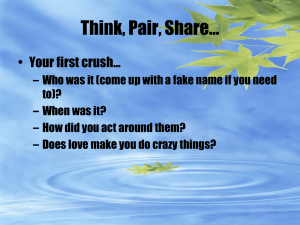Leonard Bernstein pp - Life Learning Cloud
advertisement
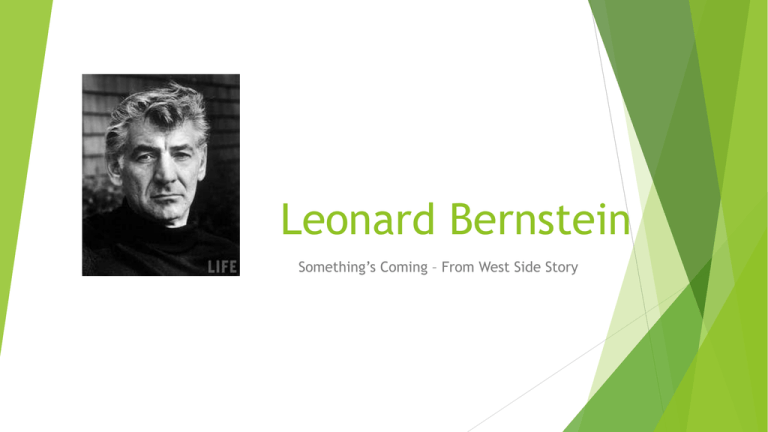
Leonard Bernstein Something’s Coming – From West Side Story Task: Copy and complete the glossary below Word Extravaganzas Melodramas Minstrelsy Dissonance Blue notes Syncopation Push rhythms Interval Tritone Riff Cross rhythms Texture Tonic Dominant Word painting Neapolitan chord duet aria Meaning Key words Something’s Coming Musical theatre How was this musical different to the previous musicals made? Some famous West end musicals are: • • • • Name some different types of musical: • • Musicals set out to entertain through a combination of: Catchy music in a popular style Solo songs, duets, choruses and ensembles Orchestra or band accompaniment Spoken dialogue Dance sequences, stage spectacles and magnificent costumes Performers compete for a musical theatre role in the BBC's 'Any Dream Will Do' These are all held together by the plot. Musicals are usually performed in theatres, most famously on Broadway and in the West End of London. Broadway is also used as a general term to refer to American musicals. Every musical has a: Libretto - the overall text including the spoken and sung parts Lyrics - the words to the songs Most songs are either: Action songs, which move the plot forward or Character songs, which enable a character to express their feelings The orchestra....... There are a large number of instruments in the West Side Story orchestra with particularly large woodwind, brass and percussion sections. As is common in theatre pit orchestras (or bands), the players in these sections often play more than one instrument. This is known as doubling. Additional instruments: Complete the following: ____ woodwind players ____ violins ___ horns _____ cellos ____ trumpets ____ double basses ____ players in total. Theme A Look at the first theme. Notice the tritone between the bass note C and the F sharp in the vocal line. The F sharp resolves onto a G. Listen to Theme A. The mood is quite tentative. Notice the tritone. Theme B Look at the contrasting second theme. Notice the declamatory repeated notes and the use of accents. Listen to Theme B at its first appearance. The mood is much more confident with a loud dynamic and accented notes. Theme C Look at the third theme. Notice the use of long sustained notes, legato phrases and rising intervals. Listen to Theme C at its first appearance. Notice the lyrical melody and the optimistic mood. Key techniques used.... Cross rhythm Push rhythms Syncopation Jazz based harmony Interval of the tritone Short riffs Polyphony Sustained notes 1. How does Bernstein create a sense of excitement and expectancy in this song? 2. Mention two techniques or devices that the composer uses in this song and throughout the music itself 3. Describe the harmony used in the song. 4. What is a push rhythm? Give an example. 5. What is a blue note? Give an example. 6. Describe the orchestration of the piece. 7. How are the words ‘the air is humming’ depicted by the orchestra? 8. How does the piece end? 9. This is a solo song or aria. Name two other types of vocal forms used in a musical. 10. What makes the subject matter of West Side Story different and new from other Broadway musicals of the time? 1. Bernstein uses a fast tempo (crotchet = 176) and driving rhythms to create a sense of excitement. 2. Bernstein uses several techniques and devices in Something’s Coming, these include word painting, cross rhythms, push rhythms and tri tones. 3. Bernstein uses jazz based harmony (added blue notes) to create dissonances. He also uses tri tones and neoploitan chords. 4. Push rhythms are notes that anticipate the beat by being tied on to the beat (usually in this piece by a quaver). 5. A blue note is a note from a blues scale. It has a minor interval when a major one is expected. These create dissonances as the notes do not belong in the home key. 6. The orchestration of the piece consists of 5 woodwind players doubling (playing more that 1 instrument i.e. flute and sax), 2 horns, 3 trumpets, 2 trombones, 7 violins, 4 cellos, 2 double basses, + drum lit, 2 extra percussionists, guitar (electric and bass), and piano. 30 in total. 7. 8. The piece ends with an ad lib fade. 9. Other vocal forms in musicals include, duets, trios and chorus numbers. 10. It is based on a Shakespear’s play ‘Romeo and Juliet.
